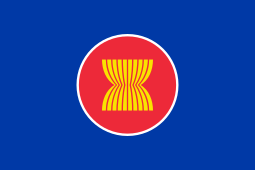Flag of ASEAN
 | |
| Proportion | 2:3 |
|---|---|
| Design | The ASEAN emblem on a blue background. |
The Flag of the Association of Southeast Asian Nations is one of the official symbols of the Association of Southeast Asian Nations (ASEAN).[1] It consists of the official emblem of ASEAN on a blue background.
Design

Construction
Set upon a blue background, ten paddy or rice stalks are drawn in the middle of a red circle with white circumference.
The colours of the flag are specified as follows:
| Scheme | Blue | Red | White | Yellow |
|---|---|---|---|---|
| Pantone | Pantone 286 | Pantone Red 032 | Pantone Process Yellow | |
| CMYK | C100-M60-Y0-K6 | C0-M91-Y87-K0 | C0-M0-Y0-K0 | C0-M0-Y100-K0 |
| RGB | 34-85-158 | 227-49-49 | 255-255-255 | 248-244-0 |
The ratio of width to length of the flag is 2:3. The ASEAN Charter includes size specifications for usage of the flag:[2]
- Table flag: 10 cm x 15 cm
- Room flag: 100 cm x 150 cm
- Car flag: 20 cm x 30 cm
- Field flag: 200 cm x 300 cm
Symbolism
The official symbolism of the flag is detailed in the ASEAN Charter. Blue represents peace and stability, red represents courage and dynamism, white represents purity, and yellow represents prosperity.[2]
The stalks symbolise ASEAN's ten members.
The colours of the flag – blue, red, white, and yellow – represent the main colours of the national flags of all ten ASEAN member states.[2]
History
ASEAN's previous flag was similar to the current one - it had five paddy stalks representing the five founding members and the word ASEAN written under the stalks. The background was white instead of blue, the border of the circle along with the word ASEAN was cyan, and the circle was bright yellow. The stalks themselves were golden brownish in colour.
References
External links
- ASEAN - Official description of the flag
- ASEAN Charter
- Flag of the World - Description at FotW along with history
